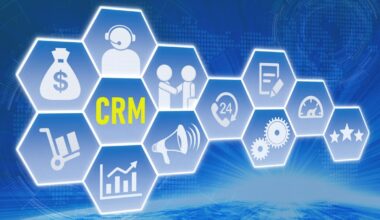Integrating Behavioral Economics in Consumer Behavior Models
Understanding consumer behavior is critical for businesses aiming to increase productivity and engage their target audience effectively. To improve consumer behavior models, many companies are turning to the framework of behavioral economics, which examines the psychological and emotional factors that influence consumer decision-making. Unlike classical economic theories, behavioral economics considers irrational behaviors that deviate from standard economic predictions. By recognizing these irrational tendencies, companies can refine their strategies to better align with actual consumer behaviors. For example, the use of heuristics, or mental shortcuts, often guides consumers in their purchasing decisions. This insight can help companies design marketing strategies that resonate more deeply with customers, ultimately leading to increased loyalty and repeat purchases. Moreover, understanding concepts like loss aversion helps in creating pricing strategies that can mitigate risks in consumers’ minds. They aim to minimize perceived losses while maximizing perceived gains. Combining behavioral economics with traditional consumer behavior models adds depth to research, helping marketing professionals understand more than just demographics. This holistic view drives better product development and customer segmentation, ensuring relevance and connection with consumers.
As the discipline of behavioral economics continues to evolve, its application becomes increasingly apparent in various aspects of consumer behavior modeling. By integrating insights from behavioral economics, marketers strategically alter their approaches to align with how consumers truly think and act. One significant aspect of behavioral economics is the concept of framing, which refers to how information is presented and perceived. Through framing, businesses can highlight specific features of their products or services in a way that appeals to consumer emotions rather than just logical reasoning. For example, a company might market a product by emphasizing the potential savings consumers will experience, thereby appealing to their fear of loss rather than focusing on the price itself. This tactic often results in heightened consumer engagement and positive responses. Additionally, the use of social proof, where consumers look to others when making decisions, demonstrates another effective integration of behavioral economics. Businesses can leverage this by showcasing testimonials or user-generated content to influence new buyers. Understanding these intricate behaviors allows marketers to create compelling narratives that resonate with their audience, leading to enhanced conversion rates and customer satisfaction.
Furthermore, applying behavioral economics in consumer behavior models necessitates a solid understanding of cognitive biases, factors that affect judgment and decision-making in unpredictable ways. Many consumers fall victim to biases, such as confirmation bias, where they favor information that confirms their existing beliefs. By recognizing these biases, marketers can tailor their messaging to challenge consumers’ preconceptions gently yet effectively. For instance, employing counter-narratives that broaden the perspective of potential customers can stimulate interest and pique curiosity. Another common bias is the status quo bias, which can hinder consumers from adopting new products or services. Companies can effectively counter this by emphasizing the benefits of change and reinforcing ease of transition strategies. Behavioral economics also highlights the importance of scarcity and urgency, which can drive consumer engagement and decisions. By communicating limited availability or time-sensitive offers, marketers can create a sense of urgency that prompts quicker purchasing actions. Integrating these insights offers businesses a more nuanced understanding of their customers’ motivations, leading to tailored marketing campaigns that resonate and drive sales effectively.
The Role of Emotions in Consumer Decision-Making
Emotions play a pivotal role in consumer decision-making, and the integration of behavioral economics shines a spotlight on this aspect. Traditional economic models often overlook the weight of emotional responses, focusing solely on rational choice theories. However, behavioral economics acknowledges that emotions significantly shape purchasing behaviors and preferences. Marketers can employ emotional branding strategies that evoke positive feelings associated with products, thereby encouraging consumer loyalty. For example, using stories that resonate with customers on an emotional level can create stronger connections that ultimately drive purchasing decisions. Companies that successfully implement emotionally driven marketing campaigns frequently see improved customer retention and brand advocacy. Moreover, understanding that different consumers have distinct emotional triggers can guide companies in segmenting their audiences more effectively. This allows businesses to create personalized experiences that cater to individual emotional needs or aspirations. By acknowledging the emotional landscape of consumer decisions, marketers can craft more compelling experiences that not only meet functional needs but also fulfill deeper emotional desires, ultimately leading to deeper consumer engagement and success in competitive markets.
Additionally, the integration of behavioral economics offers a comprehensive toolkit for analyzing consumer motivations beyond superficial data. For businesses looking to innovate or enhance their offerings, understanding deeper emotional drivers becomes essential. A thorough exploration of behavioral triggers illuminates the ‘why’ behind consumer actions rather than merely focusing on the ‘what.’ By delving into psychological factors related to consumer satisfaction, businesses can tailor product offerings that align with true customer needs and preferences. Research methodologies in this area can go beyond traditional surveys, employing observational studies and experiments that uncover insightful data. Techniques that incorporate real-world conditions often yield richer insights into consumer behavior compared to controlled environments. Additionally, continuous learning and adaptation are key principles in leveraging behavioral economics for real-world applications. Marketing teams must remain vigilant, regularly reviewing marketing strategies to assess how well they align with evolving consumer behaviors. Adjusting campaigns based on feedback and market trends helps maintain relevance and effectiveness in promoting products or services.
Collaboration between marketers and behavioral economists can drive innovative approaches to consumer models. Such partnerships foster a shared understanding of the evolving dynamics between consumer desires and market demands. Involving behavioral experts within marketing teams ensures that insights drawn from psychology complement traditional market research methods. This interdisciplinary approach encourages creative thinking, where solutions stem from a diverse pool of knowledge and expertise. Businesses willing to invest in training and development in behavioral economics can empower their marketing teams to make data-informed decisions that resonate with consumers on a deeper level. Furthermore, utilizing data analytics tools alongside behavioral insights can highlight patterns and trends that reveal how consumers interact with brands in real-time. This enables agile adjustments to marketing strategies that can significantly enhance customer engagement. Ultimately, advocating for continuous education in behavioral economics for marketing professionals can create a more effective approach to consumer behavior models, thus fostering improved customer relationships that stand the test of evolving market conditions.
Conclusion: The Future of Consumer Behavior Models
In conclusion, integrating behavioral economics into consumer behavior models is not just a trend but a necessity in today’s complex market landscape. As consumer needs become more sophisticated, marketers must equip themselves with the tools and insights gained from behavioral economics to create strategies that succeed. Acknowledging the emotional, psychological, and behavioral factors at play allows businesses to connect with their audiences more meaningfully. Moreover, leveraging these insights not only fosters better marketing strategies but also enhances product development, customer experience programs, and overall organizational strategies. As organizations evolve, those that prioritize understanding their customers through the lens of behavioral economics will undoubtedly stand out in the competitive marketplace. Companies that continuously adapt and innovate their methodologies based on consumer behavior insights will not only meet market demands but also exceed consumer expectations. Thus, the integration of behavioral economics into consumer behavior models represents a vital step towards evolving marketing practices that drive success in the future.
Research into consumer behavior has shown that integrating behavioral economics offers a fresh perspective on traditional marketing methods. Marketers equipped with knowledge of behavioral insights achieve better consumer alignment. Behavioral economics reveals why consumers might choose products that seem illogical, such as purchasing luxury items when cheaper alternatives exist. Understanding consumer psychology helps businesses create more relevant messaging that resonates. Factors such as cognitive load can impact decisions, leading to overwhelming consumers when too many choices are presented. By simplifying their options, companies can increase sales and allow for smoother decision-making experiences. Additionally, the concept of nudging encourages behaviors that lead consumers toward desired actions without removing freedom of choice. Companies can design environments that steer choices while maintaining customer autonomy. These nudges can take various forms: from strategically placing products in stores to prodding website users towards completing a purchase. Effective nudging requires an understanding of the consumer’s journey and pinpointing where intervention could be most beneficial. By applying these principles thoughtfully in campaigns, businesses can enhance overall customer experiences and satisfaction, ultimately driving growth and profitability.


